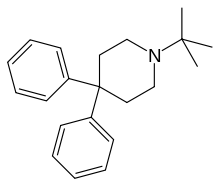Budipine
Budipine (brand name Parkinsan) is an antiparkinson agent marketed for the treatment of Parkinson's disease.[2][3]
 | |
| Clinical data | |
|---|---|
| AHFS/Drugs.com | International Drug Names |
| ATC code | |
| Identifiers | |
| |
| CAS Number | |
| PubChem CID | |
| ChemSpider | |
| UNII | |
| KEGG | |
| ChEMBL | |
| CompTox Dashboard (EPA) | |
| ECHA InfoCard | 100.055.494 |
| Chemical and physical data | |
| Formula | C21H27N |
| Molar mass | 293.454 g·mol−1 |
| 3D model (JSmol) | |
| |
| |
| (verify) | |
While its exact mechanism of action is not well characterized,[2] it is believed to be an NMDA receptor antagonist,[4][5] but also promoting the synthesis of dopamine.[6]
Because it provides additional benefits relative to existing treatments, it probably does not precisely mimic the mechanism of an existing known treatment.[6][7]
See also
References
- Martndale: The Complete Drug Reference, 35th Ed.
- Heinz Reichmann (October 2006). "Budipine in Parkinson's tremor". Journal of the Neurological Sciences. 248 (1–2): 53–55. doi:10.1016/j.jns.2006.05.039. PMID 16784759.
- H. Przuntek; T. Müller (1999). Clinical efficacy of budipine in Parkinson's disease. Journal of Neural Transmission. Supplementa. 56. pp. 75–82. doi:10.1007/978-3-7091-6360-3_3. ISBN 978-3-211-83275-2. PMID 10370903.
- Kornhuber J., Herr B., Thome J., Riederer P. (1995). "The antiparkinsonian drug budipine binds to NMDA and sigma receptors in postmortem human brain tissue". J. Neural Transm. Suppl. 46: 127–133. PMID 8821048.CS1 maint: multiple names: authors list (link)
- Gene C. Palmer (September 2001). "Neuroprotection by NMDA receptor antagonists in a variety of neuropathologies". Current Drug Targets. 2 (3): 241–271. doi:10.2174/1389450013348335. PMID 11554551.
- Przuntek H, Bittkau S, Bliesath H, et al. (May 2002). "Budipine provides additional benefit in patients with Parkinson disease receiving a stable optimum dopaminergic drug regimen". Arch. Neurol. 59 (5): 803–6. doi:10.1001/archneur.59.5.803. PMID 12020263. Archived from the original on 2011-08-10. Retrieved 2008-08-04.
- Jenny C.E. Owen; Peter S. Whitton (October 2006). "Effects of amantadine and budipine on antidepressant drug-evoked changes in extracellular dopamine in the frontal cortex of freely moving rats". Brain Research. 1117 (1): 206–212. doi:10.1016/j.brainres.2006.07.039. PMID 16996043.
This article is issued from Wikipedia. The text is licensed under Creative Commons - Attribution - Sharealike. Additional terms may apply for the media files.